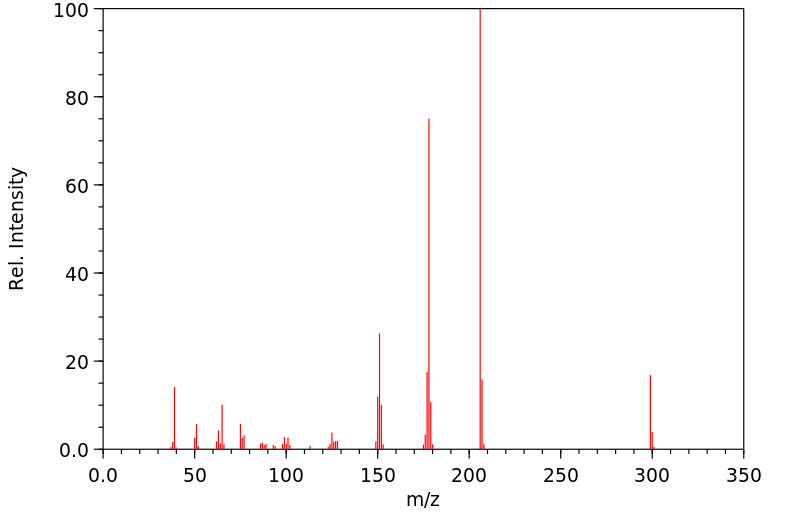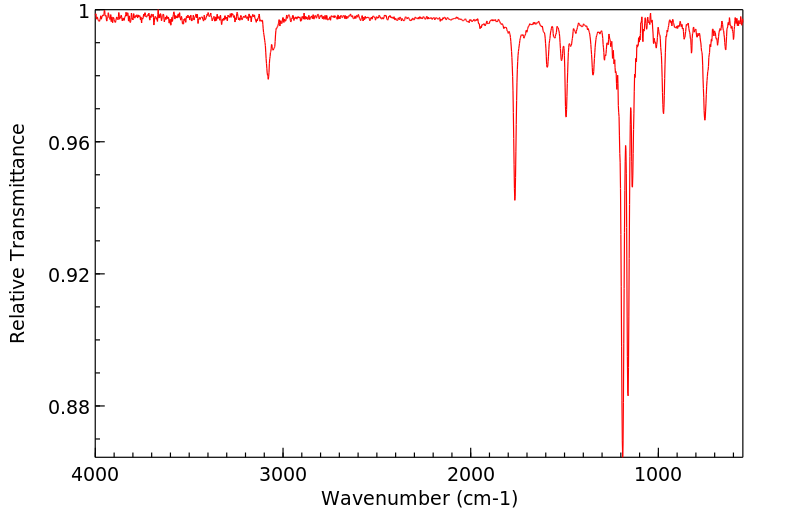苯基吖啶-9-羧酸酯 | 109392-90-7
物质功能分类
中文名称
苯基吖啶-9-羧酸酯
中文别名
9-吖啶羧酸苯酯
英文名称
phenyl acridine-9-carboxylate
英文别名
9-(phenoxycarbonyl)-acridine;phenyl 9-acridinecarboxylate
CAS
109392-90-7
化学式
C20H13NO2
mdl
——
分子量
299.329
InChiKey
QIYUZWMXMSNPRG-UHFFFAOYSA-N
BEILSTEIN
——
EINECS
——
-
物化性质
-
计算性质
-
ADMET
-
安全信息
-
SDS
-
制备方法与用途
-
上下游信息
-
文献信息
-
表征谱图
-
同类化合物
-
相关功能分类
-
相关结构分类
物化性质
-
熔点:188-192 °C
-
沸点:440.65°C (rough estimate)
-
密度:1.2079 (rough estimate)
-
稳定性/保质期:
遵照规定使用和储存,则不会分解。
计算性质
-
辛醇/水分配系数(LogP):4.9
-
重原子数:23
-
可旋转键数:3
-
环数:4.0
-
sp3杂化的碳原子比例:0.0
-
拓扑面积:39.2
-
氢给体数:0
-
氢受体数:3
安全信息
-
危险品标志:Xi
-
安全说明:S37/39
-
危险类别码:R36/37/38
-
海关编码:2933990090
-
危险性防范说明:P261,P305+P351+P338
-
危险性描述:H315,H319,H335
-
储存条件:存放于阴凉干燥处
SDS
| Name: | Phenyl Acridine-9-Carboxylate Material Safety Data Sheet |
| Synonym: | None |
| CAS: | 109392-90-7 |
Synonym:None
Section 2 - COMPOSITION, INFORMATION ON INGREDIENTS
| CAS# | Chemical Name | content | EINECS# |
| 109392-90-7 | Phenyl Acridin | ca 100 | unlisted |
Risk Phrases: 36/37/38
Section 3 - HAZARDS IDENTIFICATION
EMERGENCY OVERVIEW
Irritating to eyes, respiratory system and skin.The toxicological properties of this material have not been fully investigated.
Potential Health Effects
Eye:
Causes eye irritation.
Skin:
Causes skin irritation.
Ingestion:
May cause gastrointestinal irritation with nausea, vomiting and diarrhea. The toxicological properties of this substance have not been fully investigated.
Inhalation:
Causes respiratory tract irritation. The toxicological properties of this substance have not been fully investigated.
Chronic:
No information found.
Section 4 - FIRST AID MEASURES
Eyes: Immediately flush eyes with plenty of water for at least 15 minutes, occasionally lifting the upper and lower eyelids. Get medical aid.
Skin:
Get medical aid. Flush skin with plenty of water for at least 15 minutes while removing contaminated clothing and shoes. Wash clothing before reuse.
Ingestion:
Get medical aid. Do NOT induce vomiting. If conscious and alert, rinse mouth and drink 2-4 cupfuls of milk or water.
Inhalation:
Remove from exposure and move to fresh air immediately. If not breathing, give artificial respiration. If breathing is difficult, give oxygen. Get medical aid.
Notes to Physician:
Treat symptomatically and supportively.
Section 5 - FIRE FIGHTING MEASURES
General Information:
As in any fire, wear a self-contained breathing apparatus in pressure-demand, MSHA/NIOSH (approved or equivalent), and full protective gear. During a fire, irritating and highly toxic gases may be generated by thermal decomposition or combustion.
Extinguishing Media:
Use agent most appropriate to extinguish fire. Use water spray, dry chemical, carbon dioxide, or appropriate foam.
Section 6 - ACCIDENTAL RELEASE MEASURES
General Information: Use proper personal protective equipment as indicated in Section 8.
Spills/Leaks:
Vacuum or sweep up material and place into a suitable disposal container. Clean up spills immediately, observing precautions in the Protective Equipment section. Avoid generating dusty conditions.
Provide ventilation.
Section 7 - HANDLING and STORAGE
Handling:
Wash thoroughly after handling. Remove contaminated clothing and wash before reuse. Minimize dust generation and accumulation. Avoid contact with eyes, skin, and clothing. Keep container tightly closed.
Avoid ingestion and inhalation. Use with adequate ventilation.
Storage:
Store in a tightly closed container. Store in a cool, dry, well-ventilated area away from incompatible substances.
Section 8 - EXPOSURE CONTROLS, PERSONAL PROTECTION
Engineering Controls:
Facilities storing or utilizing this material should be equipped with an eyewash facility and a safety shower. Use adequate ventilation to keep airborne concentrations low.
Exposure Limits CAS# 109392-90-7: Personal Protective Equipment Eyes: Wear appropriate protective eyeglasses or chemical safety goggles as described by OSHA's eye and face protection regulations in 29 CFR 1910.133 or European Standard EN166.
Skin:
Wear appropriate protective gloves to prevent skin exposure.
Clothing:
Wear appropriate protective clothing to prevent skin exposure.
Respirators:
A respiratory protection program that meets OSHA's 29 CFR 1910.134 and ANSI Z88.2 requirements or European Standard EN 149 must be followed whenever workplace conditions warrant respirator use.
Section 9 - PHYSICAL AND CHEMICAL PROPERTIES
Physical State: Crystalline powder
Color: tan
Odor: Not available.
pH: Not available.
Vapor Pressure: Not available.
Viscosity: Not available.
Boiling Point: Not available.
Freezing/Melting Point: 190 deg C
Autoignition Temperature: Not applicable.
Flash Point: Not applicable.
Explosion Limits, lower: Not available.
Explosion Limits, upper: Not available.
Decomposition Temperature:
Solubility in water:
Specific Gravity/Density:
Molecular Formula: C20H13NO2
Molecular Weight: 299.32
Section 10 - STABILITY AND REACTIVITY
Chemical Stability:
Stable at room temperature in closed containers under normal storage and handling conditions.
Conditions to Avoid:
Incompatible materials, dust generation, excess heat, strong oxidants.
Incompatibilities with Other Materials:
Oxidizing agents.
Hazardous Decomposition Products:
Nitrogen oxides, carbon monoxide, irritating and toxic fumes and gases, carbon dioxide.
Hazardous Polymerization: Has not been reported
Section 11 - TOXICOLOGICAL INFORMATION
RTECS#:
CAS# 109392-90-7 unlisted.
LD50/LC50:
Not available.
Carcinogenicity:
Phenyl Acridin - Not listed by ACGIH, IARC, or NTP.
Section 12 - ECOLOGICAL INFORMATION
Section 13 - DISPOSAL CONSIDERATIONS
Dispose of in a manner consistent with federal, state, and local regulations.
Section 14 - TRANSPORT INFORMATION
IATA
Not regulated as a hazardous material.
IMO
Not regulated as a hazardous material.
RID/ADR
Not regulated as a hazardous material.
Section 15 - REGULATORY INFORMATION
European/International Regulations
European Labeling in Accordance with EC Directives
Hazard Symbols: XI
Risk Phrases:
R 36/37/38 Irritating to eyes, respiratory system
and skin.
Safety Phrases:
S 26 In case of contact with eyes, rinse immediately
with plenty of water and seek medical advice.
S 28A After contact with skin, wash immediately with
plenty of water.
S 37 Wear suitable gloves.
S 37/39 Wear suitable gloves and eye/face
protection.
S 45 In case of accident or if you feel unwell, seek
medical advice immediately (show the label where
possible).
WGK (Water Danger/Protection)
CAS# 109392-90-7: No information available.
Canada
None of the chemicals in this product are listed on the DSL/NDSL list.
CAS# 109392-90-7 is not listed on Canada's Ingredient Disclosure List.
US FEDERAL
TSCA
CAS# 109392-90-7 is not listed on the TSCA inventory.
It is for research and development use only.
SECTION 16 - ADDITIONAL INFORMATION
N/A
上下游信息
反应信息
-
作为反应物:描述:参考文献:名称:涉及酸性和环境离子发光体的化学发光。9-吖啶过羧酸根阴离子的化学发光摘要:9-吖啶羧酸苯酯与过量的过氧化离子在 THF/水 (67/33 mol%) 中的反应导致发射亮黄绿色光或亮蓝色光,具体取决于反应条件。例如,高浓度的过氧化氢和水有利于蓝色发射。9-吖啶过羧酸是反应中常见的中间体。负责蓝色化学发光的发光体是吖啶酮,而负责黄绿色化学发光的发光体是吖啶酮的阴离子。碱浓度和溶剂组成对这两种发射体的相对比例的影响已经证明,与简单理论的预期相反,二氧杂环丁酮不是反应中的中间体。DOI:10.1021/ja00251a024
-
作为产物:描述:参考文献:名称:涉及酸性和环境离子发光体的化学发光。9-吖啶过羧酸根阴离子的化学发光摘要:9-吖啶羧酸苯酯与过量的过氧化离子在 THF/水 (67/33 mol%) 中的反应导致发射亮黄绿色光或亮蓝色光,具体取决于反应条件。例如,高浓度的过氧化氢和水有利于蓝色发射。9-吖啶过羧酸是反应中常见的中间体。负责蓝色化学发光的发光体是吖啶酮,而负责黄绿色化学发光的发光体是吖啶酮的阴离子。碱浓度和溶剂组成对这两种发射体的相对比例的影响已经证明,与简单理论的预期相反,二氧杂环丁酮不是反应中的中间体。DOI:10.1021/ja00251a024
文献信息
-
Strongly Chemiluminescent Acridinium Esters under Neutral Conditions: Synthesis, Properties, Determination, and Theoretical Study作者:Manabu Nakazono、Yuji Oshikawa、Mizuho Nakamura、Hidehiro Kubota、Shinkoh NanbuDOI:10.1021/acs.joc.6b02748日期:2017.3.3mechanism was composed of the nucleophilic addition reaction of hydroperoxide anion, dioxetanone ring formation, and nonadiabatic transition due to spin–orbit coupling around the transition state (TS) to the triplet state (T1) following the decomposition pathway. The TS which appeared in the thermal decomposition would be a rate-determining step for all three processes.合成了具有苯基和联苯基部分的各种新型a啶鎓酯衍生物,并研究了它们的最佳化学发光条件。发现了几种在中性条件下强烈化学发光的cri啶鎓酯,然后将这些衍生物用于检测过氧化氢和葡萄糖。具有强吸电子基团如氰基,甲氧羰基,和硝基在苯基部分的4-位上的苯基-10-甲基吖啶10λ酯4吖啶-9-羧酸盐三氟甲磺酸显示出强的化学发光强度。的化学发光强度3,4-二氰基苯基-10-甲基10λ 4吖啶-9-羧酸盐三氟甲磺酸较苯基-10-甲基10λ的强约100倍4在pH为7的过氧化氢和葡萄糖的线性校准范围吖啶-9-羧酸盐三氟甲磺酸使用0.05〜10 mM和10-2000μM3,4-(二甲氧基羰基)苯基-10-甲基10λ 4 -acridine- 9-羧酸盐三氟甲磺酸盐分别在pH 7和pH 7.5下。通过密度泛函理论的量子化学计算,评价了proposed啶鎓酯通过二氧杂环丁酮结构的化学发光反应机理。所提出的机理是由氢过氧
-
Spectral features of substituted 9-(phenoxycarbonyl)-acridines and their protonated and methylated cation derivatives作者:Karol Krzymiński、Alexander D. Roshal、Agnieszka NiziołekDOI:10.1016/j.saa.2007.10.045日期:2008.7The long-wavelength absorption of eight 9-(phenoxycarbonyl)-acridines and the 10-H-9-(phenoxycarbonyl)-acridinium and 10-methyl-9-(phenoxycarbonyl)-acridinium cations derived from them, substituted with an alkyl or trifluoroalkyl group at the benzene ring, occurs above 300 nm as the superposition of four bands. Three of these bands occupy comparable positions (expressed in nm) in all the compounds;从烷基或三氟烷基取代的8个9-(苯氧羰基)-ac啶和10-H-9-(苯氧羰基)-rid啶鎓和10-甲基-9-(苯氧羰基)-ac啶鎓阳离子的长波吸收苯环上的基团出现在300 nm以上,是四个谱带的重叠。在所有化合物中,这些带中的三个占据了相当的位置(以nm表示)。然而,第四种改变了位置,在中性分子中以低于400 nm的长波肩出现,但在阳离子中以高于400 nm的近乎独立的谱带出现。在长波长吸收带内激发产生的弱荧光相对于吸收发生红移,因此中性分子和阳离子的斯托克斯频移相似。斯托克斯位移倾向于随介质的定向极化率而增加。计算预测,长波长电子跃迁伴随着分子的结构变化。他们还表明,在这种跃迁之后,整个分子中的电子密度将发生大致均匀的变化,同时偶极矩也会发生细微变化,这说明了长波长区域的吸收较弱。预测的辐射失活速率常数和非辐射失活速率常数表明,在研究的分子中发生了有效的自旋-轨道耦合,这是荧光量子产率相
-
Chemiluminogenic Features of 10-Methyl-9-(phenoxycarbonyl)acridinium Trifluoromethanesulfonates Alkyl Substituted at the Benzene Ring in Aqueous Media作者:Karol Krzymiński、Agnieszka Ożóg、Piotr Malecha、Alexander D. Roshal、Agnieszka Wróblewska、Beata Zadykowicz、Jerzy BłażejowskiDOI:10.1021/jo1020882日期:2011.2.18electronically excited 10-methyl-9-acridinone, whose relaxation was accompanied by chemiluminescence (CL). The kinetic constants of CL decay, relative efficiencies of light emission, chemiluminescence quantum yields, and resistance toward alkaline hydrolysis were determined experimentally under various conditions. The mechanism of CL generation is considered on the basis of thermodynamic and kinetic parameters合成,纯化和鉴定了在苯环上带有烷基取代基的10-甲基-9-(苯氧羰基)ac基三氟甲烷磺酸盐。在与OOH的反应中-在碱性水性介质中,所研究化合物的阳离子被转化为电子激发的10-甲基-9-ac啶酮,其弛豫伴随着化学发光(CL)。在各种条件下,通过实验确定了CL衰减的动力学常数,相对发光效率,化学发光量子产率以及对碱水解的抵抗力。根据在DFT理论水平预测的反应步骤的热力学和动力学参数,考虑了CL生成的机理。化学发光效率是通过在OOH亲核取代之间C(9)的电中心的竞争的结果-或者OH -以及由此形成的中间体分解为电子激发的10-甲基-9-ac啶酮的能力。鉴定稳定的和中间的反应产物证实了建议的反应方案。获得的结果,尤其是“有用性”参数的依赖性(考虑了CL量子产率和水解的敏感性)对氧化过程中去除的实体腔体积的依赖,形成了合理设计化学发光的便捷框架10 -甲基-9-(苯氧羰基)ac阳离子。
-
N-alkylacridan carboxyl derivatives useful for chemiluminescent detection申请人:Lumigen, Inc.公开号:US05491072A1公开(公告)日:1996-02-13N-alkylacridan carboxylic acid derivative compounds (I) are used to generate chemiluminescence by the action of a peroxidase enzyme and an oxidant. The compounds I are useful in assays of all types.
-
Vibrational spectra of phenyl acridine-9-carboxylates and their 10-methylated cations: A theoretical and experimental study作者:B. Zadykowicz、A. Ożóg、K. KrzymińskiDOI:10.1016/j.saa.2010.02.014日期:2010.5Infrared spectra of phenyl acridine-9-carboxylates and their 10-methylated cationic derivatives were recorded and discussed. Experimental data were compared with theoretically predicted transitions at the DFT level of theory (using the B3LYP functional and 6-31G** basis set) for optimized geometries of molecules. Substitution influences the values of the wavenumbers of characteristic stretching and
表征谱图
-
氢谱1HNMR
-
质谱MS
-
碳谱13CNMR
-
红外IR
-
拉曼Raman
-
峰位数据
-
峰位匹配
-
表征信息
同类化合物
(S)-4-(叔丁基)-2-(喹啉-2-基)-4,5-二氢噁唑
(SP-4-1)-二氯双(喹啉)-钯
(E)-2-氰基-3-[5-(2,5-二氯苯基)呋喃-2-基]-N-喹啉-8-基丙-2-烯酰胺
(8α,9S)-(+)-9-氨基-七氢呋喃-6''-醇,值90%
(6,7-二甲氧基-4-(3,4,5-三甲氧基苯基)喹啉)
(1-羟基-5-硝基-8-氧代-8,8-dihydroquinolinium)
黄尿酸 8-甲基醚
麻保沙星EP杂质D
麻保沙星EP杂质B
麻保沙星EP杂质A
麦角腈甲磺酸盐
麦角腈
麦角灵
麦皮星酮
麦特氧特
高铁试剂
高氯酸3-苯基[1,3]噻唑并[3,2-f]5-氮杂菲-4-正离子
马波沙星EP杂质F
马波沙星
马来酸茚达特罗杂质
马来酸茚达特罗
马来酸维吖啶
马来酸来那替尼
马来酸四甲基铵
香草木宁碱
颜料红R-122
颜料红210
颜料红
顺式-苯并(f)喹啉-7,8-二醇-9,10-环氧化物
顺式-(alphaR)-N-(4-氯苯基)-4-(6-氟-4-喹啉基)-alpha-甲基环己烷乙酰胺
非那沙星
非那沙星
青花椒碱
青色素863
雷西莫特
隐花青
阿莫地喹-d10
阿莫地喹
阿莫吡喹N-氧化物
阿美帕利
阿米诺喹
阿立哌唑溴代杂质
阿立哌唑杂质B
阿立哌唑杂质38
阿立哌唑杂质1750
阿立哌唑杂质13
阿立哌唑杂质
阿立哌唑杂质
阿尔马尔
阿加曲班杂质43








